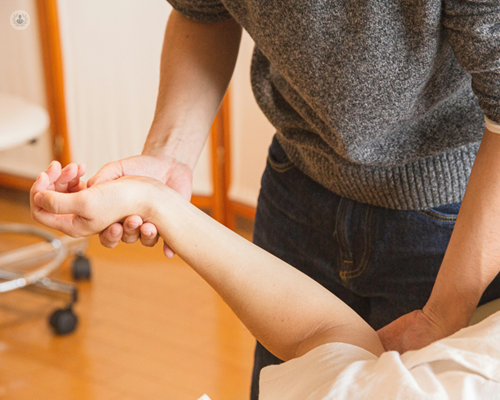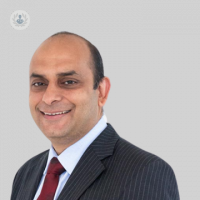Exploring tennis elbow: Causes, symptoms, and treatment - ‘Time to elbow the pain’
Written by:Leading orthopaedic surgeon Mr Arvind Mohan goes into expert detail about tennis elbow, or lateral epicondylalgia, in this informative article.

What is tennis elbow?
Tennis elbow, clinically known as lateral epicondylalgia, is a common condition that causes pain and tenderness on the outer part of the elbow. Despite its name, tennis elbow is not limited to tennis players and can affect anyone who performs repetitive motions involving the forearm muscles.
What causes tennis elbow?
Overuse or repetitive motion
Repetitive activities that involve gripping, twisting, or lifting can strain the tendons in the forearm, leading to tendinosis and pain.
Common activities associated with tennis elbow include playing racquet sports, such as tennis or squash, gardening, painting, and typing.
Poor technique or equipment
Improper technique during sports activities, such as using a backhand stroke in tennis with poor form, can increase the risk of developing tennis elbow.
Using equipment that is too heavy or not properly sized for the individual can also contribute to the development of this condition.
Age and degeneration
As people age, the tendons in the elbow may degenerate and become less flexible, making them more susceptible to injury and tendinosis.
Over time, wear and tear on the tendons can lead to microtears and damage, contributing to the development of tennis elbow.
What are the symptoms of tennis elbow?
Pain and tenderness
The primary symptom of tennis elbow is pain and tenderness on the outer part of the elbow, which may radiate down the forearm.
The pain typically worsens with activities that involve gripping or lifting objects and may improve with rest.
Weakness and stiffness
Some individuals with tennis elbow may experience weakness in the forearm muscles, making it difficult to grip objects or perform everyday tasks.
Stiffness in the elbow joint and limited range of motion may also be present, especially after periods of inactivity.
How is tennis elbow diagnosed?
Medical history and physical examination
A healthcare professional will review the patient's medical history and conduct a physical examination to assess for signs of pain and tenderness in the elbow.
They may also ask about the patient's occupation, sports activities, and any recent changes in activity level.
Imaging tests
In some cases, imaging tests such as X-rays or magnetic resonance imaging (MRI) may be ordered to rule out other potential causes of elbow pain, such as fractures or arthritis.
What are the treatment options for tennis elbow?
Rest and activity modification
Resting the affected arm and avoiding activities that exacerbate symptoms can help alleviate pain and promote healing.
Modifying technique or equipment used during sports or occupational activities may also be beneficial.
Physical therapy
A structured physical therapy program focused on stretching and eccentric strengthening exercises can help improve flexibility and reduce pain in the affected elbow.
Techniques such as massage, ultrasound therapy, and electrical stimulation may also be used to alleviate symptoms.
Medications
Nonsteroidal anti-inflammatory drugs (NSAIDs) such as ibuprofen or naproxen may be prescribed to reduce pain. Corticosteroid injections may be recommended but growing evidence has shown that there is no significant inflammation instead there is a picture of tendinosis which is mainly degeneration in the tendon. There is growing evidence of randomised controlled trials that corticosteroids mostly give short term relief but do run a risk of collateral damage to important underling ligaments of the elbow. Instead, its relevant to consider biological treatment like platelet rich plasma (PRP) or viscosupplements.
Bracing and orthotics
Wearing a brace or forearm strap can help alleviate strain on the affected tendons and provide support during activities.
Custom orthotics or ergonomic aids may also be recommended to improve biomechanics and reduce stress on the elbow joint.
Surgery
In cases where conservative treatments fail to provide relief, surgical intervention may be considered.
Common surgical procedures for tennis elbow include tendon debridement, tendon release, or tendon repair to remove damaged tissue and alleviate pressure on the affected tendons.
Require expert treatment for tennis elbow? Arrange a consultation with Mr Mohan via his Top Doctors profile.


